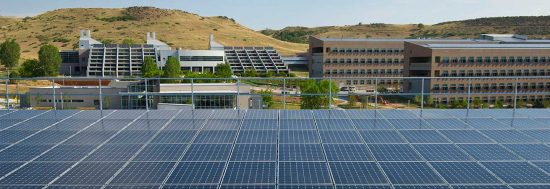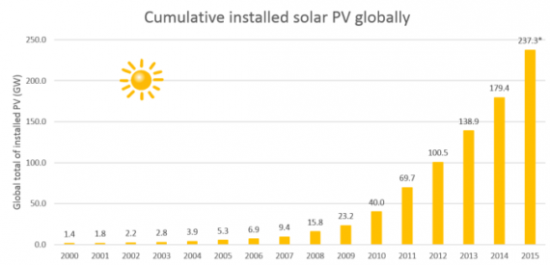April 21, 2017 – Scientists from the United States, Japan, and Germany have outlined how the planet can get solar capacity up to 10 terawatts in the next 13 years. In 2015 solar power from photovoltaics generated 1% of electricity globally and 20% of new installation capacity. That represented 71 gigawatts of energy. That’s a far cry from 10 terawatts.
What’s interesting so far about photovoltaics is how the industry continues to underestimate the decline in cost per watt of energy produced largely because of China’s significant commitment to the technology. Compared to the cost of photovoltaic-produced energy today, forecasts extending to 2025 predict a drop of 59% per watt which will make solar the cheapest form of power generation.
The declining cost is just one factor in the prediction offered by the Fraunhofer Institute for Solar Energy (Germany), the National Institute of Advanced Industrial Science and Technology (Japan), and the National Renewable Energy Laboratory (United States). The latter is the primary national laboratory for studying renewable energy and research and development into improving energy efficiency. There is no indication as of yet on whether the laboratory may be subjected to significant cuts should President Trump’s proposed budget become the law of the land. But in the meantime, the work continues on finding a way to eliminate the burning of carbon to generate energy with solar a weapon of choice for power generation.

The experts say 5 to 10 terawatts is doable by 2030 if:
- the cost of photovoltaics continues to drop (which is happening although at a decreasing rate of decline)
- the performance of photovoltaics continues to improve (which is happening as well with perovskite solar cells and other materials increasing conversion efficiencies to near 30%)
- manufacturing capacity expands as economies of scale make it possible to absorb the declining prices per unit of production while generating profit (this is the most problematic of the conditions because a number of early solar companies in North America have gone under as global competition, mainly from China, has made them uneconomic)
- development of flexible, smart grids capable of handling photovoltaics (this is an area where a lot more research and development and investment is needed)
- utilities building up energy storage capacity commensurate with the growth in photovoltaic capacity (this is already starting to happen with large battery storage being pioneered by Exxon, Tesla and a number of other companies)
- growth in electricity demand as transportation moves to electric vehicles, and heating, and cooling gets off natural gas (the electric vehicle era is getting closer to achieving critical mass, and new materials and retrofitting construction may help reduce the need for electricity in homes and buildings)
The scientists from the three countries have issued a report in which they state they are convinced solar will become so cheap it will be the most attractive choice for power generation deployed locally or over grids. But getting there, however, must overcome current advantages still held by natural gas and coal for generating utility-scale electricity.
As of 2015 solar power generated by energy utility companies cost 13 cents per kilowatt hour, considerably more than coal and gas at 5 and 10 cents. The cost of building utility-sized solar in 2015 was $1.80 per watt compared to natural gas thermal at $1 to 1.30 and coal-fired at $3. Solar is continuing to drop in price with the International Renewable Energy Agency predicting drops to 79 cents per watt by 2025. The advantages of natural gas in these circumstances will drop as the fossil fuel becomes non-competitive. And despite President Trump’s promise to get coal miners back to work, the fossil fuel today is no longer competitive with either solar or natural gas. That disadvantage will increase even more in eight years.
Today in Dubai, the Masdar Abu Dhabi Future Energy Company, and in Saudi Arabia, Abdul Latif Jameel, are currently bidding on solar projects with a delivery cost of 2.99 cents per kilowatt hour. That’s 40% cheaper than the lowest-cost fossil fuel plant in operation today.
And note, the numbers being quoted do not include residential solar panel installations both on and off grid. Those prices including installation and material costs have dropped from about $11 per kilowatt hour in 2000 to less than $1 today.









